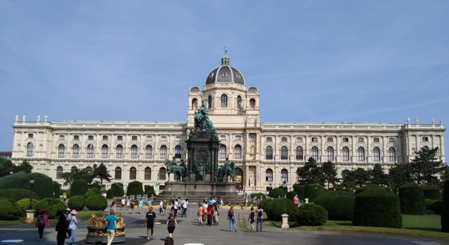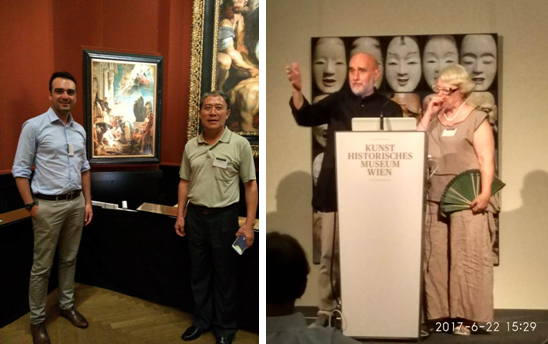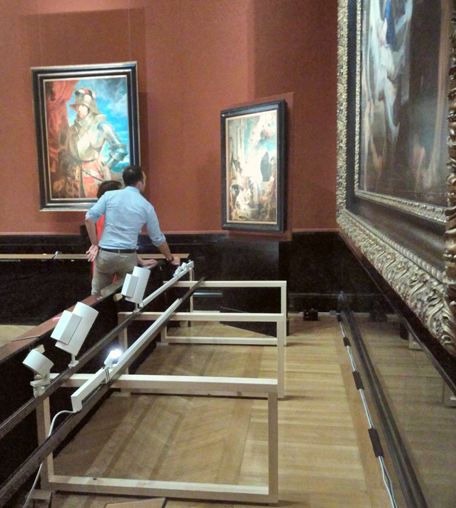
Jiang Naiqun
(Shenzhen Chuangxian Lighting Technology Co., Ltd.)
Abstract: The Monza lighting method is designed to enhance the experience of both museum visitors and cultural heritage researchers. It draws on the principles of mirror neurons and neuro-aesthetics, utilizing advanced LED lighting technology and specialized illumination techniques to support the appreciation of ancient oil paintings.
Keywords: Monza illumination method; mirror neuron; neuro-aesthetics; cool white light; warm white light
After developing the Monza Method for the appreciation of ancient paintings, with the support of the World Heritage Fund (WHF) and the European Lighting Design Convention (PLDC), Italian lighting designers Francesco Iannone and Serena Tellini have been promoting this innovative technology across Europe and Singapore.
The research behind the Monza lighting method aligns with several high-tech fields supported by the Chinese government in 2017, including cultural and creative industry technologies, as well as cultural heritage discovery and reuse technologies. Specifically, it supports the development of tools for the discovery, protection, restoration, and identification of cultural relics. This makes the Monza lighting method a key component in the field of cultural preservation, and its implementation has received official endorsement.
In June of this year, PLDC organized a three-day event titled "Immersive Art" at the Kunsthistorisches Museum in Vienna, Austria. The event featured the Monza Lighting Workstation and seminars, where the author was invited to participate. Attendees included representatives from Germany, France, Singapore, the United States, South Korea, and Austria, along with cultural relics experts, university professors, and lighting designers. See Figures 1 and 2.

Figure 1 PLDC hosts Austrian Vienna lighting workstations and seminars

Figure 2 Austrian Museum of Art History, Austria
During the workshop, participants were divided into eight groups, each working on improving the lighting of an ancient painting. As part of Group 3, the author collaborated with Italian representative Dario Maccheroni to enhance the lighting of “The Miracles of St. Francis†by Peter Paul Rubens. The lighting effect is shown in Figure 3. A detailed report from Group 3 is provided in Annex 1.
The final presentation by Francesco and Selena is illustrated in Figure 4, where they discussed the invention of the Monza lighting method. More details can be found in Annex 2.

Figure 3 (left) The miracle of the ancient painting St. Francis, the real effect of the template lighting effect
Figure 4 (right) Francisco and Selena are speaking on Monza Lighting
The Monza lighting method is based on the theory of mirror neurons and neuro-aesthetics, aiming to provide a better viewing experience for both the public and cultural experts. The core of the method involves selectively projecting white light of different color temperatures and intensities from the bottom of the audience toward the ancient paintings. Before implementation, lighting designers analyze the colors and their distribution on the painting. Using state-of-the-art LED equipment, they choose between warm white (3000-3500K), neutral white (4000-5500K), or cool white (5500-7500K) lights for different areas of the artwork, adjusting angles, intensity, and placement accordingly. This process is illustrated in Figure 5.

Figure 5: Monza lighting method workstation operation, setting of different types of LED track lights
By enhancing the lighting, ancient paintings appear more vivid and engaging to the audience, making the stories within them more impactful and memorable. For cultural experts, improved lighting also facilitates more detailed analysis of the artwork.
The Monza method utilizes LED track lights to optimize the space between the paintings and the guardrails, allowing for testing and implementing the best lighting solutions. Based on these solutions, designers and museum staff can create new guardrails that conceal the LED lights, power cables, infrared sensors, and even cameras for monitoring and protection.
Following the successful Vienna workshop, PLDC will host a global lighting design conference in Paris from November 1st to 4th. The event will bring together 38 universities and over 50 multinational companies, covering topics such as cultural heritage lighting, urban lighting, education, and lighting products, as shown in Figure 6.

Figure 6 PLDC held Paris meeting on November 1-4, 2017
At the conference, Francesco and Selena will deliver a speech titled "Lessons Learned," scheduled for Thursday, November 2nd at 12:15 pm. Later, Alberto Pasetti from Italy will present on "How Neurosciences Influence Lighting Design and Visual Perception."
[Annex 1] Jiang Naiqun, Dolly McLoni. St. Francis's Miracle, Template. In-depth Art Workstation Work. 2017.06.22
![]() 170729F Annex I goes deep into the art workstation job.ppt
170729F Annex I goes deep into the art workstation job.ppt
[Annex 2] Francesco, Selena. Monza Lighting Law. 2017.06.22
![]() 170729F Annex II Monza Lighting Method.doc
170729F Annex II Monza Lighting Method.doc
References
[1] Su Xiaomeng. Analysis of the current situation of museum lighting and improvement design research [J]. China Lighting Appliances, 2009(8)7-11
[2] Alison Ritter, Targetti, Frascoco Iannone. Lighting Works of Art by Titian [J].
PROFESSIONAL LIGHTING DESIGN, 2013,87.
[3]Jiang Naiqun. A preliminary study on the appreciation of ancient paintings[J]. Proceedings of the 2015 China Lighting Forum, 210-219
[4] Dang Rui, Wang Lixiong, Liu Gang. Research on Key Issues in Protective Lighting of Cultural Relics[J]. Journal of Lighting Engineering, 2013.10增
Publication 122-126
Dropout Fuse Cutout and load drop fuse cutout are outdoor used high-voltage protective devices. They are connected with the main lines of the distribution transformer or the distribution wires to protect the transformer or wires from short circuit and overload, and on/off loading current. Dropout fuse cutout consists of insulating bracket and fuse tube. The static contacts are fixed on the two ends of bracket, while the moving contacts are fixed on the two ends of fuse tube. Fuse tube is composed of inner extinction tube and the outer epoxy glass tube. The load drop fuse cutout is added with elastic supporting contacts and arcing shield for switching on-off loading current. In normal operation, the fuse tube will form an enclosure via its tightened fuse link. The fuse will be melt off quickly and form an arc if there is any fault, the extinction tube is heated by the arc, exploding much gas to give high pressure into the tube and blow along with the tube, so the arc is quickly elongated and extinguished. When the fuse is cut off, moving contacts at the bottom turn down without tension; the locking frame will release the fuse, so the fuse drops to form obvious break. When it needs to put load on, start the contact with insulating cod, then the static and moving contacts are still keeping in touch, keep pulling the contacts till the supporting contacts apart. Then there is the arc among the supporting contacts, which is prolonged in the narrow space of arcing shield.At the same time, the arc extinguishing cover generates gas, and the arc is extinguished when the current exceeds zero.
Porcelain Fuse Cutout,Drop Fuse Cutout,Fuse Link Cut Out,Cutout Fuse Holder
Jilin Nengxing Electrical Equipment Co. Ltd. , https://www.nengxingelectric.com